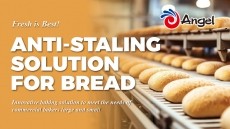Dispatches from Anuga FoodTec 2015
Oven ‘kill step’ isn’t enough for bakery food safety, warns expert

FSMA was written into law in 2011, but the FDA is still finalizing implementation laws on parts of the act.
Karin Blacow, food safety specialist at Commercial Food Sanitation – a partner of conveyor firm Intralox – said the act was a “game changer” for the global market and should work to kick-start increased safety concern among bakers.
“I don’t want to say the general baking industry is really bad – some companies are really getting there, but there are still improvements possible and unfortunately there are still companies out there that just haven’t gotten it yet and don’t really see the need,” she told BakeryandSnacks.com at Anuga FoodTec 2015 in Cologne last month.
“Companies often say ‘because my product is going through a fryer or oven anyway it’s going to kill everything’,” she said.
However, she said this wasn’t always the case. “It is a kill step, but a kill step only reduces your bacteria levels. So, let’s say you had a bacteria issue and it’s a high level of bacteria, you’re not going to kill it all.”
Mold growth and bacteria risk
Blacow said bakery lines had several stages where bacteria could take hold. For example, dough or flour could easily fall off the line during proofing and form mold or pathogens and bacteria could get locked into fabric reinforced conveyor belt cracks.
“Bakery has different risks. The risk of actually having a pathogen outbreak that will kill people is very small… But you still need to produce under sanitary conditions; it needs to be safe. You don’t want mold on your product, for example. When you get mold, it very easily travels through air so your mold can spread everywhere and that’s not easy to get rid of,” she said.
Asked what the easiest food safety change for bakers to make was, she said: “I would get to conveyor belts because they are direct food contact.”
Conveyor belts that could be easily cleaned would be a good first investment, she said.
In addition, she said some simple employee training could make all the difference. “Think about your cleaning procedures; train your people and make them aware. It’s not that people are deliberately walking on a belt to clean, for example, it’s just they’re not thinking about it. It’s all about education.”
Small step changes
Blacow said investments in food safety should be done in “baby steps”.
“It’s not about building the perfect factory, it is when you build a new factory, but for a factory that is 30 years old you can’t expect to turn it into a new factory. Every little thing you do, and that your supplier and equipment manufacturer does, helps in improving food safety,” she said.
Simple, hygienic design should be the ultimate goal for bakers, she said, irrespective of cost.
“People ask me to offer hygienic design and then I do but they then choose the cheapest option. I’m not saying hygienic design is cheaper, but it does not necessarily have to be more expensive. It’s more expensive in the beginning because you need to spend engineering time. If you have built a system for 20 years a certain way, you now have to re-engineer that – that’s the initial investment you have to make.”
The FSMA ripple effect
Blacow said the FSMA Act in the US would have a ripple effect on the global food network, including bakers.
“Now with FSMA, it doesn’t matter what industry you’re from, you need to get your act together and that’s going to affect food safety globally.
“…I like to compare it with a train. When a train starts up, it starts slow and it’s easier to jump on. But once it’s going full boot, it’s really difficult to jump on,” she said.

















